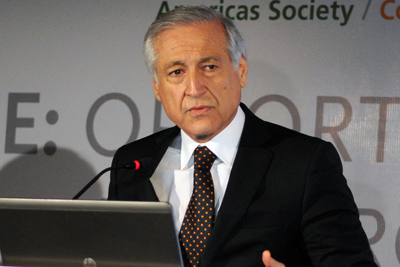Santiago 2015 Blog: Chile Keeps Investment Up Amid Regional Slowdown
Renewable energies and some of Latin America’s largest mergers meant a boost in 2014 foreign direct investment.
In the midst of a slowing regional economy, Chile saw an uptick in investment flows last year. Foreign direct investment (FDI) to the South American country rose 14 percent to $22.0 billion in 2014 from $19.3 billion in 2013. Chile was the only country among Latin America’s seven largest economies that saw FDI grow—the region overall saw a 16 percent drop—placing it neck and neck with Mexico for second-largest recipient of FDI. Mexico, however, edged it out with $22.8 billion in FDI inflows.
The hike comes on the heels of a 32 percent drop the year before from a record high of $28.5 billion in 2012. Chile’s mining and energy sectors drew the most interest, and several of the region’s largest mergers and acquisitions took place in Chile, which helped fatten the local investment pool.
As the world’s largest copper producer, Chile’s mining sector reels in a large portion of the country’s investments. But as the metal becomes cheaper, investment in mining is decelerating. That said, analysts expect copper prices to stabilize in the next couple years, and in 2010 (the most recent year for which data is available) investments in the mining sector still were seeing returns as high as 25 percent. Canada’s Lundin Mining Corporation set its eyes on the Chilean sector last year and acquired 80 percent of the Candelaria and Ojos del Salado mining projects for $1.85 billion. Additionally, Australia’s BHP Billiton—which owns a controlling stake in Escondida, the largest copper mine in the world—announced a $1.97 billion desalination project at the mine in 2013, for which it disbursed payments throughout 2014.
|
|
In the meantime, copper mines strain the country’s energy matrix, but the high demand has created an opportunity for investors. Renewable energy sources, in particular, are drawing international attention, most notably from Spain, Chile’s second largest purveyor of FDI. In 2014, Spain’s Abengoa announced $750 million in FDI for solar energy. The multinational corporation has plans to create the largest solar thermal plant on the continent. The approximately $1.8 billion project in the Atacama Desert—which plans to produce energy continuously 24 hours a day, 365 days a year—falls in line with President Michelle Bachelet’s plan to increase the production of unconventional renewable sources.
In one of the largest mergers and acquisitions made in Latin America in 2014, the Spanish company Gas Natural bought 54 percent of Chile utilities group Compañia General de Electricidad for $3.3 billion in November. The deal made Gas Natural the largest distributor of electricity in the South American country, with 40 percent of the market share in electricity.
Other large deals gave Chilean investment flows a boost, especially Brazilian bank Itaú Unibanco’s buyout of $2.2 billion worth of shares in Chile’s CorpBanca. The move is part of a larger deal to merge Itaú Unibanco’s branch in Chile with its stake in CorpBanca to create Itaú CorpBanca, a merger that’s expected to wrap up in 2016. If successful, the banking merger would be the largest to take place in Latin America since 2008.
While new deals and projects will determine whether a particular year is especially lucrative for Chile, FDI trends in the country are generally going up, growing an average 8.4 percent per year between 2008 and 2014. In comparison, overall FDI to Latin America has grown an average 6.3 percent in the same period.








